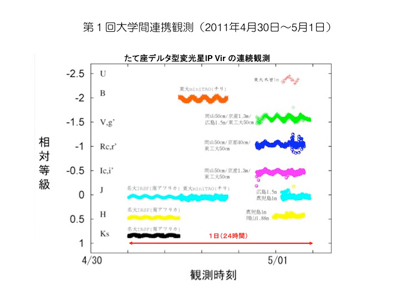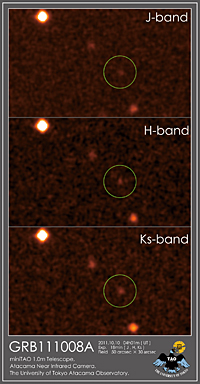
|
TAO Project |
|
The TAO project

|
"Network Construction of Optical and Infrared Synergetic Telescopes for Education and Research (OISTER)" Growing Presence of miniTAO(Please click a picture to see the larger picture with names of institutions on telescopes.) This program, OISTER, focuses on time-domain astronomy which has been relatively unexplored and conducts follow-up observations for transient objects and continuous monitoring observations for variable objects. OISTER promotes education and researches in universities by conducting cutting-edge science which can not be achieved only with large telescopes like Subaru and ALMA and foster scientists with a broad perspective and knowledge.Human interaction over different universities are also expected. One of the uniqueness of this program is to carry out campaign observations with several domestic and overseas telescopes.Observing targets are transient objects such as gamma-ray bursts and supernovae and binary systems with black holes and neutron stars to reveal their physical conditions by observing temporal changes of those objects.
The first campaign observations were conducted using 12 telescopes including ones in Chile (The University of Tokyo), South Africa (Nagoya University) from Apr. 25th to May 2nd in 2011.Thirty nine staffs, seventeen graduate students, and two undergraduate students joined this observing run. We observed two transient objects, a Type Ia Supernova SN 2011by and a recurrent nova T Pyx (T Pyxidis) which was brightened for the first time in 45 years, and light changes of three objects, Delta Scuti variable star IP Vir (IP Virginis), and two galaxies with supermvassive black holes at their centers, 1ES1215+303 and MCG-06-30-15.Our observations with miniTAO as well as those in South African Astronomical Observatory played an important role to fill in daytime in Japan (Figure below: light change of a Delta Scuti variable star)
The second campaign observations were done from Sep. 25th to Oct. 2nd in 2011 (JST).We called for observing proposals before the observations and selected a good proposal that requests intensively observing a pulsar 1FGL233.9-0513 showing light change in a time scale of several hours.This proposal requires accurate measurement of light changes
In this miniTAO observing run, we observed two transient objects, gamma-ray bursts GRB111005A (Oct. 5th) and GRB111008A (Oct. 8th), in near-infrared wavelength. These flexible observations are one of the miniTAO features.
Copyright(c) 2007-2015 TAO Project, Institute of Astronomy, Graduate School of Science, University of Tokyo
|
|||||||||||||||||||||||||||||||||||||||||||||||||||||||||

















